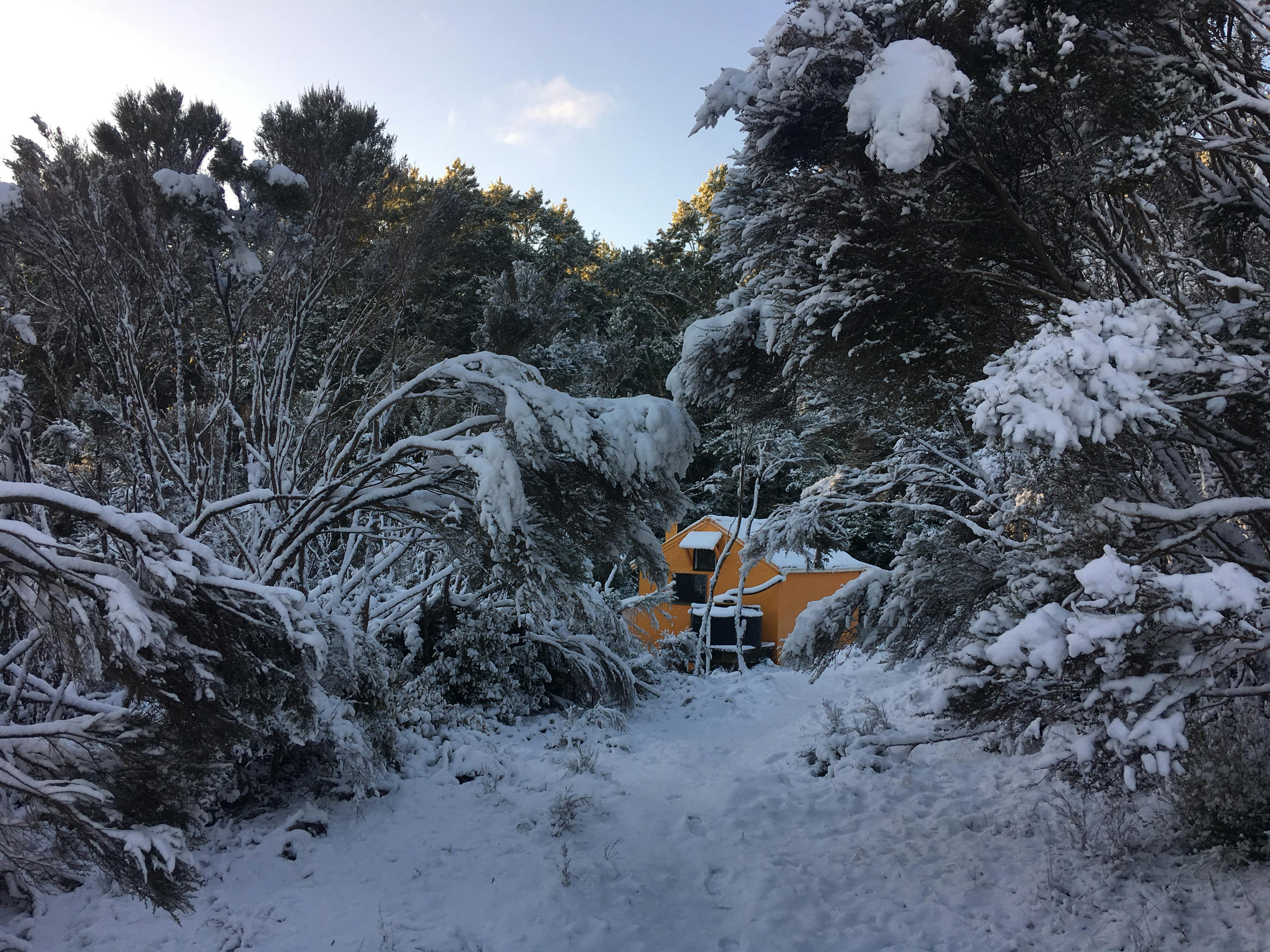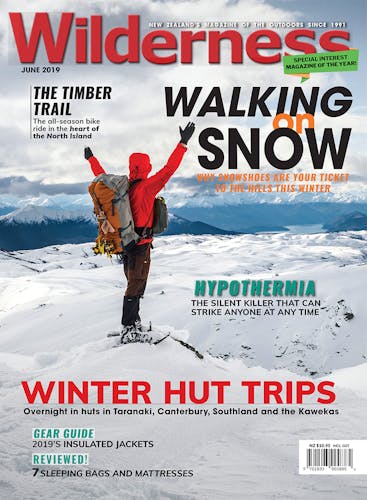Hazel Phillips undertakes an ambitious winter traverse of the Kaweka Range, right through the heart of hunting country
Tramping can teach you a lot. Lessons I recently learned include: 1) planning a 17-day trip involving significant tops travel in the Kawekas in June is almost certain to have a failure point; 2) spending the night in a hut so cold that your sleeping bag freezes won’t necessarily end in death, but equally sleeping beneath two swastikas, some devil worship symbols and a penis drawn on a bunk is not pleasant; and 3) hunters come in all sorts, from drunk and dangerous to sensible and understated. Also, 4) it’s probably a good idea to avoid tramping in the dark by headlamp in popular munter-hunter areas, and 5) your happiness is generally relative to your expectations and where you sit at any given time on Maslow’s hierarchy of needs.
The company I work for has an unusual policy around annual leave: in order to encourage people to actually use up their holiday entitlement, if you use more than 20 days in a year and have less than five days owing at the end of the financial year, they’ll gift you an extra five days. With the end of the financial year approaching, I had eight days left I needed to burn through to hit my holiday KPIs. I did a bit of finger-tramping, casting around on topo maps to see where and how I could use up a good two-week chunk of time, and came up with the Kaweka Range. The range is popular with hunters, but delights me with its abundance of authentic NZ Forest Service huts, beech forest and river systems.
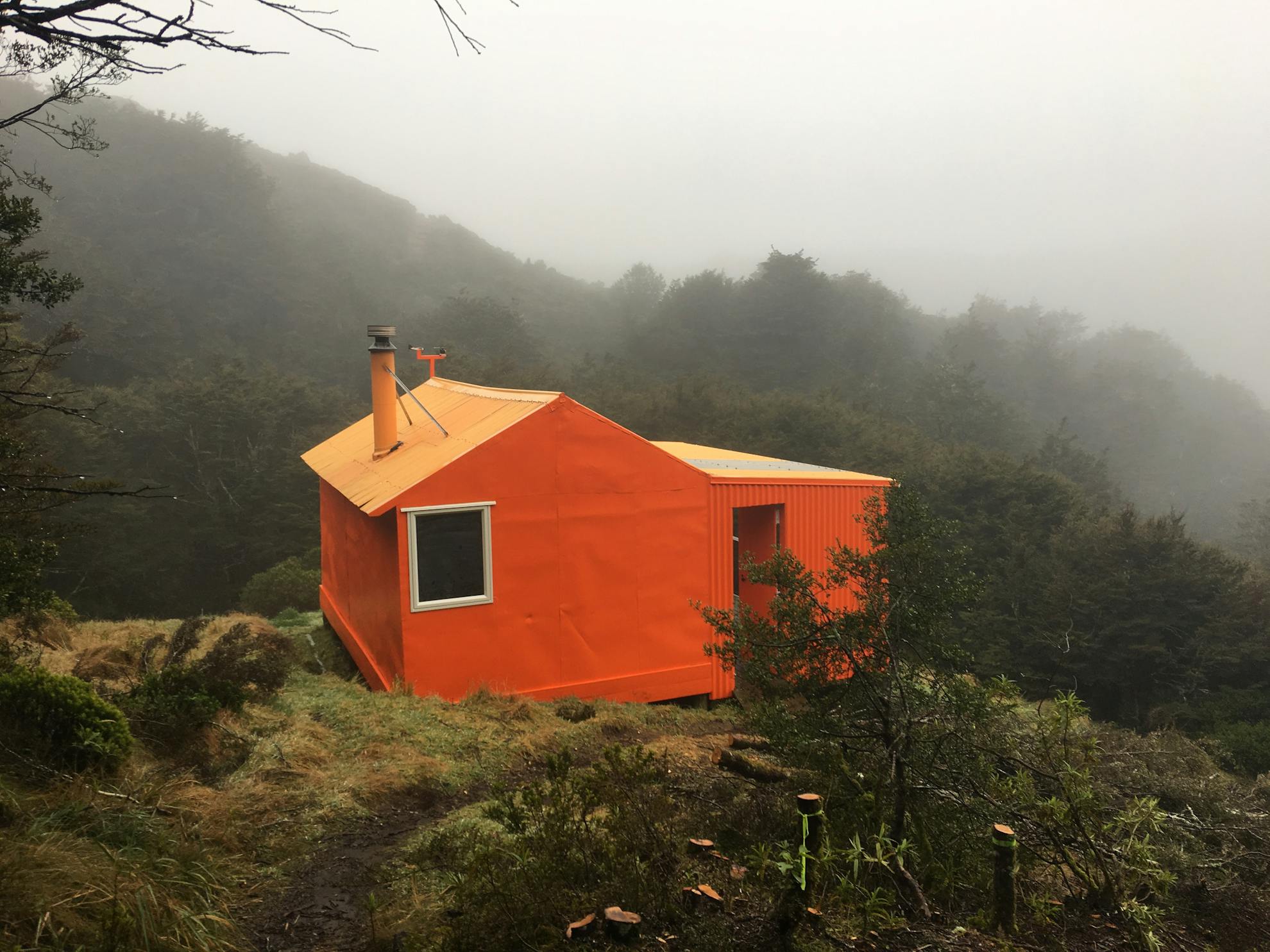
The plan: I would park my car at the Poronui Station/Helisika public car park, head out on a nine-day solo traverse, then meet my friend Nate at Makahu Saddle Hut, where we’d resupply and tackle an eight-day loop of the Kawekas.
I managed to chew most of what I bit off. But then the weather said: No.
It was the Friday of Queen’s Birthday weekend when I set out for Oamaru Hut. I’d been so focused on preparing a food and gear resupply drop for the second leg of the trip that I’d neglected to pack properly for this first stage. I’d forgotten loo paper (easily rectified in Taupo), underwear (which I realised at the car and thankfully had some spares), and a pair of hut socks. I was nearly at Oamaru Hut when I realised I’d forgotten the socks, and as the first three days of the trip involved river crossings, I knew I was looking at nine days of very cold feet. I soon came up with a strategy: I would accost the first hunter I met, and ask for his spare socks with the promise of mailing him a new pair when I got out. It never came to that, though, for, at the first hut, I found three pairs of abandoned socks. Hence lesson #5 – your happiness is relative to where you sit on the hierarchy of needs. You’ve never seen someone so happy to have a pair of stinky secondhand abandoned socks on their feet as I was at Oamaru Hut.
I had company there, three hunters who gave a bottle of rum a fair caning and then went out to shoot things in the dark. Recalling the case of Rosemary Ives, a 25-year-old camper at a popular site in Turangi who was shot dead by a hunter who thought her head torch was the eyes of a deer, I asked if it was the done thing to shoot in the dark. The answer was evasive (and I later found out that of course it really isn’t the done thing – two of the firearms maxims are ‘identify targets beyond all doubt’ and ‘never operate a firearm while under the influence of alcohol’). That led me to lesson #4; I’ve done enough tramping by headlamp to walk to huts after dark to be comfortable with it, but there’s no way I’ll ever do that again in an area that’s popular with hunters. It gave me the willies.
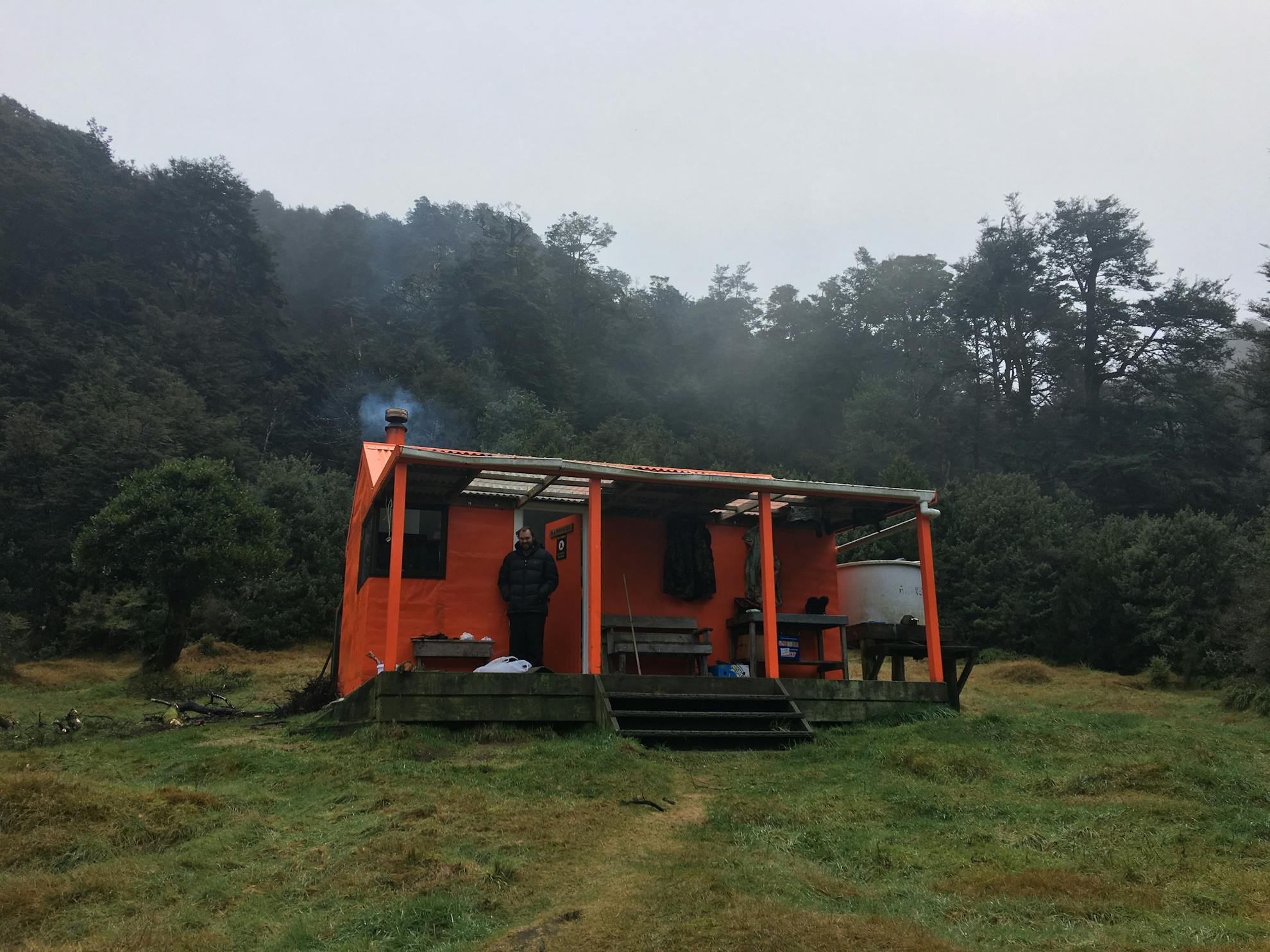
I was glad to vacate Oamaru Hut and head up the Oamaru River and over Waitawhero Saddle to Boyd Lodge. On the descent from the saddle, I met three Australian hunters sitting smack-bang in the middle of the track with their guns and some really tasty-looking cheese toasties. To be fair, their weapons may well have been empty, but the standard conditions in hunting permits say you’re not meant to shoot ‘in the vicinity of huts, tracks, campsites, road-ends or other public places’. These guys turned out to otherwise have a sensible approach to weapons, in that they didn’t get drunk and shoot at things after dark. I found out later that they watched me through binoculars to see if I’d take my boots off to cross the Ngaruroro River (I didn’t, but they had earlier), and after deciding I was tougher than them, they began to tell each other ‘mate, you need to Hazel up’. One of them had pink Ugg boots, which I coveted for my still-cold feet to no avail.
The next day, I recrossed the Ngaruroro River, had a pleasant morning tea at the well stocked and refurbished Tussock Hut and continued down Ngaawapurua (Harkness) Stream with 34 thigh-deep and very cold crossings to reach Harkness Hut. There, hunters Andrew and Rory were the epitome of polite and sensible, not to mention actually successful at shooting a couple of deer. Andrew spotted me coming from the helipad and they rushed to clean the place up and rehang two carcasses out of sight in the forest. Harkness Hut is a small but perfectly formed ex-NZFS six-bunker and its location gives hunters and trampers plenty of options for exploring the surrounds.
I spent the next three nights alone, first at Te Puke (Te Pukeohikarua) Hut, then at Mangaturutu Hut and Makino Hut. At Te Puke, the firewood was soaked so I spent the afternoon keeping warm by cutting up more for the next victim. At Mangaturutu Hut, the sunrise filtering through the trees made up for the frosty freeze overnight, which had created so much condensation inside the hut my sleeping bag dripped with water. And at Makino Hut I had just finished sorting my firewood supply for the night when fat snowflakes began to accumulate on the ground. It’s always a treat to be in a backcountry hut with a roaring firebox as the snow falls around you.
From chilly Makino Hut, I opted for the ‘five gorges’ track (or three gorges, depending on what you think constitutes a gorge) to Middle Hill Hut. The track rolls up and down a series of steep banks, each with a stream running through the bottom. I constantly spooked – and was spooked by – deer in the bush. Maybe the hunters should put down the rum and get out of the hut to find their prey.
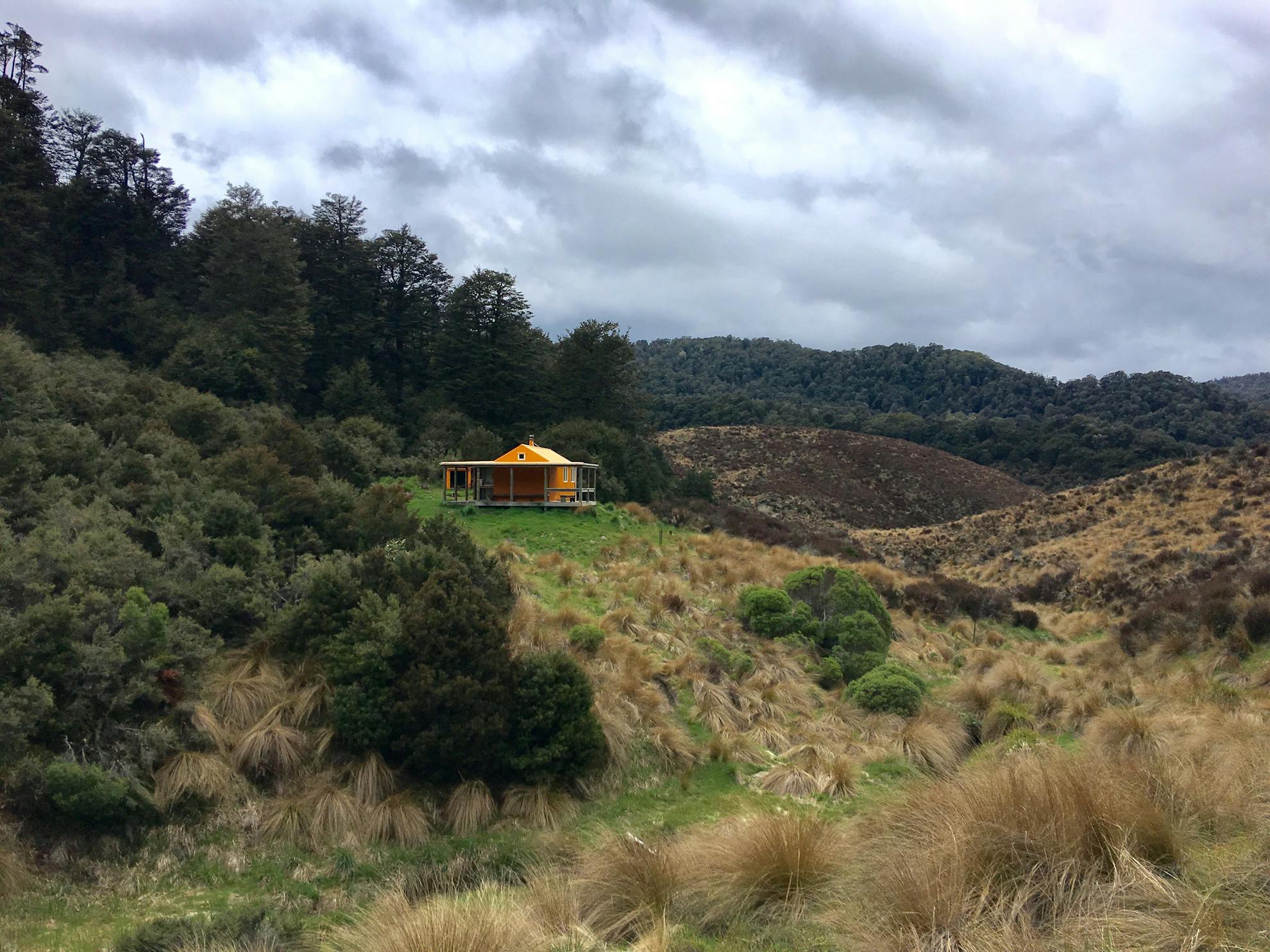
Middle Hill Hut was surrounded by snow with more falling, but thankfully it was starting to taper off and melt. Here, I met local hunter Clint, whose dog Meg was having her first backcountry outing and loving every minute.
My final leg bypassed Kaweka Flats Biv, a tiny dog box, on the way to Makahu Saddle. I later wished I’d stayed at the biv, because my night at Makahu Saddle Hut was the worst I’ve ever experienced in a hut. It’s rat-infested, with devil worship symbols scrawled on the walls and various other offensive or ill-advised pieces of graffiti on bunks, and the literacy levels of the entries in the hut books gave me pause about staying there by myself. I was terrified of who might turn up and what they might want to do when they got there. In the morning, discovering I was frozen into my sleeping bag, I was fully over it, and couldn’t wait for Nate to arrive with the resupply stocks so we could depart on leg two.
The forecast looked dicey for an eight-day trip that involved significant tops travel, but we pushed on. Dominie Biv saved the day; it’s a tiny two-bunker just 500m climb from Makahu Saddle and we opted to stay the night there due to the lack of daylight hours and an uninviting wind whipping over the tops. The next day, 10km/hr winds were predicted, so we figured we’d be home free. Mother Nature had other ideas. I was determined to push on, but after finding myself thigh deep in snow and clinging to rock on my hands and knees, we retreated and opted for an overnighter to Mackintosh Hut.
Built in 1959, Mackintosh is one of the oldest huts in Kaweka Forest Park and it has been amazingly well refurbished. It took almost four hours to get there from Makahu Saddle, with one big gorge climb down and up and a variety of bush, from pine to manuka and beech. The area around the hut has been razed by fire, sheep grazing and introduced plants and animals, and is still recovering.
Our retreat from Mackintosh Hut was snowy, icy and horrifically wet. After a swift change of clothes at the car and lots of restorative snacks, we checked the weather forecast, saw that nothing had changed and the Kaweka Ranges were still in for a smashing over the next couple of days. We admitted defeat and beat a hasty retreat to a warm ski lodge on Mt Ruapehu.
I was left kicking myself for planning such an ambitious trip involving tops travel in the Kawekas in June, of all times (see lesson #1). The constant snow and driving cold had already been tough to deal with on my solo section, but the prospect of continuing to battle it over the tops in dicey conditions was just too much. Having now been pipped at the post twice at reaching Rocks Ahead Hut and Manson Hut, I’m chalking it up to experience and adding it to my summer list – but only when there’s a good stretch of weather forecast.
- Distance
- 71.4km
- Total Ascent
- 4538m
- Grade
- Moderate
- Time
- Poronui Station to Oamaru Hut, 3-4hr; To Boyd Hut, 5-6hr; To Harkness Hut, 6hr; To Te Puke Hut, 2.5-3hr; To Mangaturutu Hut, 3hr; To Makino Hut, 5hr; To Middle Hill Hut, 4hr; To Makahu Saddle Hut, 4hr
- Access
- Public car park next to Helisika, Taharua Road off Napier-Taupo Highway
- Map
- BJ37
GPX File
- Kaweka Traverse (gpx, 37 KB)
GPX File
- Your device does not support GPX files. Please try a different device.





